User Stories¶
ALL Network Policy API resources and future API developments should start with a well-defined and intentional user story(s).
ClusterNetworkPolicy (CNP)¶
User Stories¶
The following user stories drive the concepts for ClusterNetworkPolicy
resources. Discussions on the user stories can be found here:
Story 1: Deny traffic at a cluster level¶
As a cluster admin, I want to apply non-overridable deny rules to certain pod(s) and(or) Namespace(s) that isolate the selected resources from all other cluster internal traffic.
For Example: In this diagram there is a ClusterNetworkPolicy in the Admin
tier applied to the sensitive-ns denying ingress from all other in-cluster
resources for all ports and protocols.
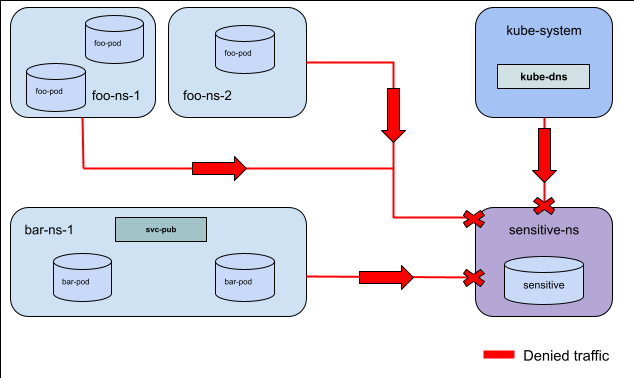
Equivalent API Object
apiVersion: policy.networking.k8s.io/v1alpha2
kind: ClusterNetworkPolicy
metadata:
name: cluster-wide-deny-example
spec:
tier: Admin
priority: 10
subject:
namespaces:
matchLabels:
kubernetes.io/metadata.name: sensitive-ns
ingress:
- action: Deny
from:
- namespaces:
matchLabels: {} # Match all namespaces.
name: select-all-deny-all
Story 2: Allow traffic at a cluster level¶
As a cluster admin, I want to apply non-overridable allow rules to certain pods(s) and(or) Namespace(s) that enable the selected resources to communicate with all other cluster internal entities.
For Example: In this diagram there is a ClusterNetworkPolicy in the Admin
tier applied to every namespace in the cluster allowing egress traffic to
kube-dns pods, and ingress traffic from pods in monitoring-ns for all ports
and protocols.
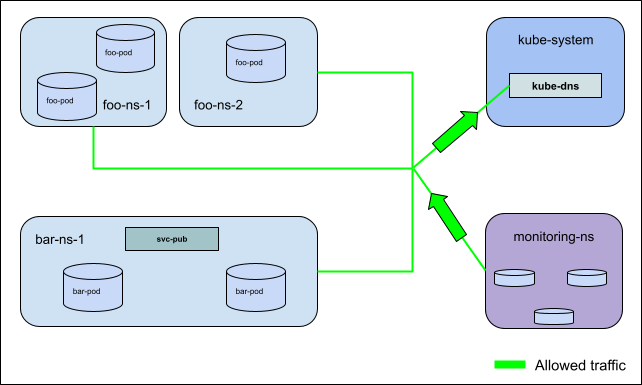
Equivalent API Object
apiVersion: policy.networking.k8s.io/v1alpha2
kind: ClusterNetworkPolicy
metadata:
name: cluster-wide-allow-example
spec:
tier: Admin
priority: 30
subject:
namespaces: {}
ingress:
- action: Accept
name: allow-monitoring-ns-ingress
from:
- namespaces:
matchLabels:
kubernetes.io/metadata.name: monitoring-ns
egress:
- action: Accept
name: allow-kube-dns-egress
to:
- pods:
namespaceSelector:
matchLabels:
kubernetes.io/metadata.name: kube-system
podSelector:
matchLabels:
app: kube-dns
Story 3: Explicitly Delegate traffic to existing K8s Network Policy¶
As a cluster admin, I want to explicitly delegate traffic so that it skips any remaining cluster network policies and is handled by standard namespace scoped network policies.
For Example: In the diagram below egress traffic destined for the service
svc-pub in namespace bar-ns-1 on TCP port 8080 is delegated to the k8s
network policies implemented in foo-ns-1 and foo-ns-2. If no k8s network
policies match the delegated traffic, the traffic will be allowed.
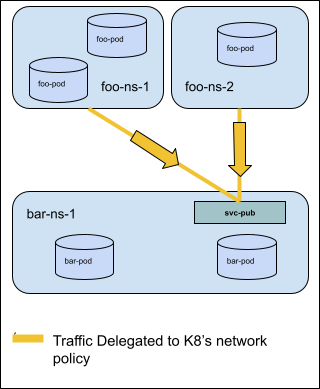
Equivalent API Object
apiVersion: policy.networking.k8s.io/v1alpha2
kind: ClusterNetworkPolicy
metadata:
name: pub-svc-delegate-example
spec:
tier: Admin
priority: 20
subject:
namespaces: {}
egress:
- action: Pass # to be handled by NetworkPolicy.
to:
- pods:
namespaceSelector:
matchLabels:
kubernetes.io/metadata.name: bar-ns-1
podSelector:
matchLabels:
app: svc-pub
ports:
- portNumber:
protocol: TCP
port: 8080
Story 4: Create and Isolate multiple tenants in a cluster¶
(Currently not implementable)
As a cluster admin, I want to build tenants in my cluster that are isolated from each other by default. Tenancy may be modeled as 1:1, where 1 tenant is mapped to a single Namespace, or 1:n, where a single tenant may own more than 1 Namespace.
For Example: In the diagram below two tenants (Foo and Bar) are defined such that all ingress traffic is denied to either tenant.
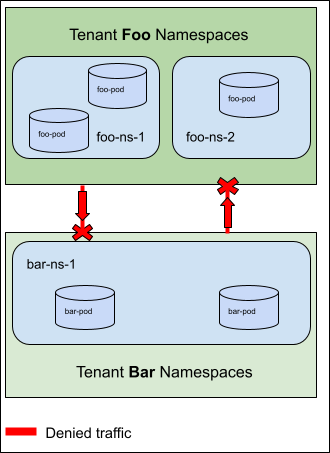
Equivalent API Object
apiVersion: policy.networking.k8s.io/v1alpha2
kind: ClusterNetworkPolicy
metadata:
name: tenant-creation-example
spec:
tier: Admin
priority: 50
subject:
namespaces:
matchExpressions: {key: "tenant"; operator: Exists}
ingress:
- action: Deny
from:
- namespaces:
# This user story is currently not implementable.
# See https://network-policy-api.sigs.k8s.io/npeps/npep-122/ for more details.
This can also be expressed in the following way:
apiVersion: policy.networking.k8s.io/v1alpha2
kind: ClusterNetworkPolicy
metadata:
name: tenant-creation-example
spec:
tier: Admin
priority: 50
subject:
namespaces:
matchExpressions: {key: "tenant"; operator: Exists}
ingress:
- action: Pass # Pass inter-tenant traffic to any defined NetworkPolicies
from:
- namespaces:
# This user story is currently not implementable.
# See https://network-policy-api.sigs.k8s.io/npeps/npep-122/ for more details.
- action: Deny # Deny everything else other than same tenant traffic
from:
- namespaces: {}
Story 5: Cluster Wide Default Guardrails¶
As a cluster admin I want to change the default security model for my cluster, so that all intra-cluster traffic (except for certain essential traffic) is blocked by default. Namespace owners will need to use NetworkPolicies to explicitly allow known traffic. This follows a whitelist model which is familiar to many security administrators, and similar to how kubernetes suggests network policy be used.
For Example: In the following diagram all Ingress traffic to every cluster resource is denied by a baseline deny rule.
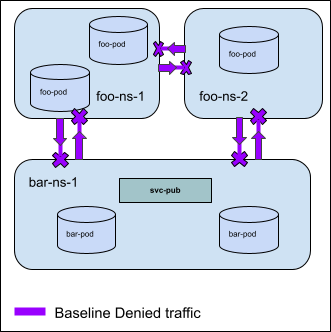
Equivalent API Object
apiVersion: policy.networking.k8s.io/v1alpha2
kind: ClusterNetworkPolicy
metadata:
name: default
spec:
tier: Baseline
priority: 10
subject:
namespaces: {}
ingress:
- action: Deny # zero-trust cluster default security posture
from:
- namespaces: {}